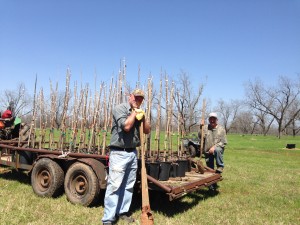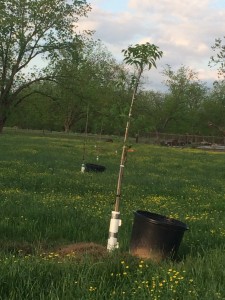Transplanting Bucket Grown Pecan Trees | Natchitoches Pecans
Posted by wernuts2 on 16th Apr 2015
In addition to the commercial importance of pecans, pecan trees add much to the beauty of the home or farm. Pecan trees should be planted in solid blocks for commercial production. For home use they can be planted along borders, ditch banks, fences, or in the lawn at least forty feet from buildings. Container grown trees - bucket trees as we term them - are usually planted from December to April. This is the best time to plant as it provides sufficient time before summer for the trees to become established. Our order for bucket trees is placed each year in early January and delivered to us in mid November. Scab resistant varieties are preferred - Elliot, Sumner, Melrose, and Candy - for our area due to the high cost of fungicides that are needed to control "scab".

As always each day brings another task that needs to be done when you manage a pecan orchard. Here at Little Eva Plantation, March is usually the month that young pecan trees are planted. Below is the guide that we try to follow when transplanting the bucket trees:
- Dig holes large enough to receive root ball - usually two feet wide and two to three feet deep (six inches deeper than the length of the root ball).
- Remove the container in which the grafted tree was growing.
- Put the root ball in hole the same depth as it had grown. You can tell where the ground line was by the difference in bark color. Trees planted too deep or too shallow may not live. With container grown trees sometimes the tap root (largest root in root ball) may be crooked or appear corkscrewed at the bottom of the bucket. If this is present, prune a little above where the root begins to curve which will encourage one or two new taproots to grow. A good root system is essential to the longevity of the tree.
- Spread lateral roots out being careful not to damage them and work good topsoil around them as you fill the hole. Do not push the lateral roots down against the tap root. If soil is clay or sand, mix in one bushel of peat moss, leafmold, or well rotted compost, (no manure and no added fertilizer at this time).
- When the hole is half full of loose topsoil, pour in at least 3 gallons of water to settle soil around the roots. Fill hole within six inches of the surface and water again. After the water settles, finish filling the hole with loose topsoil and leave a basin around the tree of sufficient size to (2" depth) hold two gallons of water.
- Put no fertilizer around trees at transplanting time. One pound of 8-8-8 or similar analysis and 1/4 pound zinc sulfate per tree may be applied shortly after leaves appear.
- Cut back central leader by 1/3 to 1/2 of the graft.
- Water weekly until a good soaking rain arrives. Thorough watering to the full depth of the roots is essential. We recycle our cattle protein tubs to help us in watering new trees. One tub is placed around each tree and remain there 12 to 18 months. Each tub holds about 20 gallons of water when filled. Three to five small holes are drilled in the bottom of each tub so that water drips out slowly ensuring thorough watering of each tree. This method is utilized throughout the year if we hit a dry spell during the summer.
- Mulch around each tree with hay or a 3' x 3' square of black plastic to help control weeds and conserve moisture.
- Growth of newly transplanted pecan trees is usually limited the first year so do not expect long shoots nor numerous leaves.
- Check frequently for insects and disease symptoms which may appear on twigs, stems or leaves.
- Remember : "A strong root system first, a vigorous stem and leaf system second, and then you should expect a good production of nuts."
.
Recycled tub acts as water source for transplanted trees.[/caption] Visit our online store to buy our fresh pecans from Louisiana.
